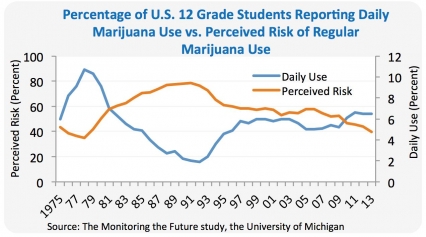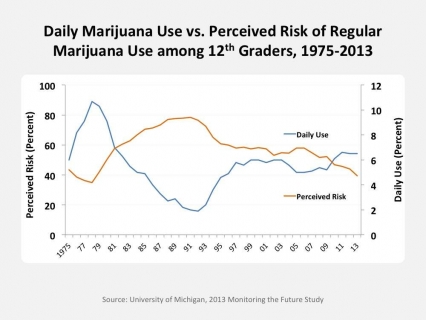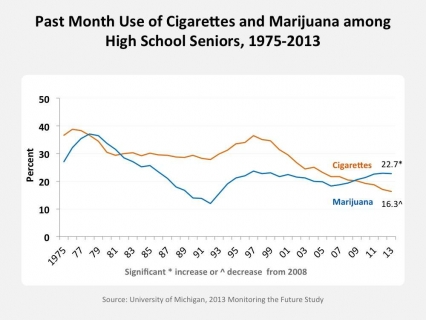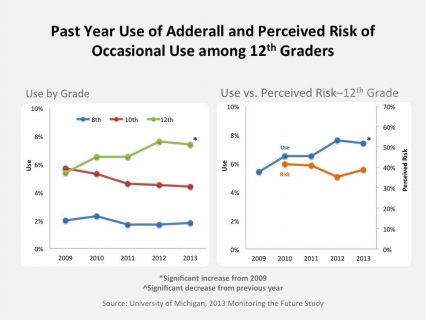This year’s Monitoring the Future Survey of drug use and attitudes among American 8th, 10th, and 12th graders continues to provide generally encouraging news, with many forms of drug use holding steady at low levels among the nation’s adolescents; however, concerns persist over the softening of attitudes around some types of drug use, particularly decreases in perceived harm and disapproval of marijuana use and perceived harm of non-medical use of prescription medications such as Vicodin, OxyContin and Adderall.
The Good News
- Cigarette smoking continues to drop and is currently at its lowest rate in the survey’s history. One-year declines were seen in lifetime and past-month use among 10th graders, and all prevalence periods have seen a continued trend of decreasing cigarette use. For example, there were significant 5-year drops in lifetime, current (past-month), and daily cigarette use among all grades. Current use was reported by 9.1% of 10th graders, down from 12.3% in 2008 and from 10.8% last year. Eighth and 12th graders also saw a drop from 2008 to 2013, from 6.8 to 4.5% for 8th graders and from 20.4% to 16.3% for 12th graders reporting past-month use. Although there were no increases between 2012 and 2013, it appears that marijuana use continues to exceed cigarette use in these students. In 2013, 22.7% of high school seniors used marijuana in the past 30 days compared with 16.3% who smoked cigarettes.
- Likewise, 5-year trends continue to show significant decreases in alcohol use among all grades and across nearly all prevalence periods. For example, from 2008 to 2013, current use of alcohol declined from 15.9% to 10.2% among 8th graders, from 28.8% to 25.7% among 10th graders, and from 43.1% to 39.2% among 12th graders. From 2012 to 2013, decreases were observed in binge use of alcohol (defined as five or more drinks in a row in the last 2 weeks) among 10th graders, with a 5-year trend showing a significant decrease in all three grades.
- Overall, the use of most illicit drugs either remained steady or declined from 2012 to 2013. For instance, past-year use of synthetic marijuana (also known as K2 or “Spice”) among high school seniors sharply decreased, from 11.3% in 2012 to 7.9% in 2013. Another harmful synthetic drug, bath salts (synthetic stimulants), was added to the survey last year; perceived risk of harm of using bath salts increased substantially among 12th graders, with 59.5% now saying they think someone who tries bath salts once or twice risks harming themselves (physically or in other ways), as compared with 33.2% giving the same response the previous year.
- This year’s survey continues to show a long-term drop in past-year nonmedical use of prescription medications. Use of the pain reliever Vicodin has decreased among all grades; among high school seniors, it dropped from 7.5% in 2012 to 5.3% in 2013. OxyContin, another pain reliever, also showed a long-term drop in use among 12th graders, from 4.7% in 2008 to 3.6% in 2013.
- Lastly, use of inhalants is at its lowest levels in the history of the survey, among all grades and across nearly all prevalence periods. Among 8th graders, for whom inhalant use has always been most prevalent, past-year use dropped to an all-time low of 5.2% in 2013.
Areas of Concern
- Five-year trends are showing significant increases in past-year and past-month (current) marijuana use across all three grades as well as increases in lifetime and daily marijuana use among 10th graders. From 2008 to 2013, past-month use increased from 5.8% to 7.0% among 8th graders, 13.8% to 18.0% among 10th graders, and from 19.4% to 22.7% among 12th graders. These increases continue to parallel softening attitudes about the perceived risk of harm and disapproval associated with marijuana use.
- Since 2010, the survey has captured the use of tobacco products other than cigarettes, such as use of hookahs to smoke tobacco, among high school seniors. Past-year hookah use has increased among 12th graders to 21.4%—the highest rate since 2010, when the survey started capturing this type of tobacco use.
- The increased abuse of prescription stimulants is also a cause for concern. The percentage of 12th graders reporting past-year nonmedical use of amphetamines rose from 6.8% in 2008 to 8.7% in 2013. Current use among 12th graders also increased from 2.9% in 2008 to 4.1% in 2013.
- Changing attitudes toward substance abuse often precede changes in reported use. Although use of Vicodin has declined, so has perception of harm among teens. In 2013, perceived risk of harm of trying Vicodin occasionally declined in 8th graders, from 29.4% to 26.2% and 10th graders, from 40.3% to 36% in 2013. This could indicate that use could begin to rise again in future years.
Videos
- Transcript: Animated Infographic: Monitoring the Future 2013 Survey Results
-
- Transcript: Teen Drug Use: 2013 Monitoring The Future Survey Results
-
[Music Introduction]
Dr. Lloyd Johnston:
Monitoring the Future is a long term series of surveys of American Young People.
We began in 1975 so this is the 39th survey in the series.
We started with high school seniors nationwide and in 1991 we added eighth and tenth graders so that we are looking at the teen years, each year.
And we survey roughly 45,000 people and almost 400 secondary schools each year.
We've seen a very, very important change in adolescent behavior since the peak years in the mid 90's.
We've seen on the order of 50-80% decline in the number of kids who are smoking, and that decline continues even today after a large drop.
We saw a lot of one-tenth drop of a percent who were smoking in the past year, between 2012 and 2013 and we saw a similar drop the previous year.
So these are a lot of people who aren't smoking who would have had they been in earlier classes.
It's going to have a major impact on the health and longevity of this cohort of people.
Well, one of the things that we have in study is a measure of perceived risk associated with each of these different substances and one of the things we have seen with marijuana in particular is a continuing decline in the perceptions of how dangerous it is to use.
So that may be an indicator of something that coming in the future.
We have already seen a rise in marijuana use for the last four or five years, and I would guess based on that advance indicator we will probably see a continual rise in the coming years.
To me one of the most important finding is some of the new drugs that come on the seen, there are always new drugs coming on to the scene.
Have shown evidence of being contained and starting to fall back.
The most prevalent of those is called synthetic marijuana, which isn't really marijuana but it contains cannabinoids which are a component in marijuana, and these synthetic drugs are sold over the counter and a number of young people have tried them.
So, it was the second most widely used class of drug last year among the older teens.
This year we see a sharp drop in the use of synthetic marijuana and I see that as an important development.
We have also seen the bath salts, they remained in very low levels, where they were last year, but in the meantime a great many more youngsters have come to recognize that they are dangerous and they are staying away from them.
One of the things that I have observed over the last many years that we have studied drug use in the country, is that there are always new drugs coming out on the scene.
A great many have come out on the scene in the years we have been looking at it, and still are.
I alway hope that young people will get the message that almost all of these substance have adverse effects.
You may not know it at first, because there haven't been enough evidence accumulated to prove it.
But, it is a good idea I think for youngsters to stay away from all of these substances because virtually all of them have adverse effects and you don't have to wait until the evidence proves it.
- Transcript: Dr. Nora Volkow Discusses MTF 2013 Highlights on Marijuana
-
Dr. Nora Volkow Speaking:
Kids are perceiving marijuana as much less harmful, even when its used regularly.
Which we believe may account for the relatively high rates that we are observing, not just having use marijuana here and there, but I think actually from regular marijuana use.
When you have 6.5 percent of kids that are in twelfth grade taking marijuana regularly, you actually start to get concerned vis-a-vis how to ultimately will affect how their brain works.
Studies have shown that regular use of marijuana is associated with a much higher rate of school drop out.
Now these are kids at school, so we really don't know what percentage of kids may have dropped out from the regular use of marijuana, implicating that perhaps this number of 6.5 percent is an underestimation if we compare the numbers that were for example in 2000 of regular use, versus now in 2013, we have seen increases in those numbers, but the 2000 level of THC was at least half of the level that we observe now, at least half.
So that means that not just were there less kids taking the drug regularly, but even those that were taking it were regularly were taking a much less potent drug.
- Transcript: Drs. Nora Volkow and Wilson Compton Discuss MTF 2013 Results
-
Dr. Nora Volkow Speaking:
So legal drugs are going down among young people.
Synthetics are going down we also have very low numbers in cocaine and heroin, those are remaining low.
Low levels also in inhalant which is a drug that is particularly problematic because the young people, the younger of the ones that we are survey, which is the 8th graders, 12 to 13 year old, they favor inhalants over other drugs because of their easy accessibility.
But inhalants are very toxic.
Not just vis-a-vis there harmful effects on the brain, they actually can produce death from asphyxiation and we are seeing decrease.
Which is actually very good because there was a point where we have seen a couple of years with significant increase in the 8th graders and that is going down
Dr. Wilson Compton Speaking:
One of the pieces of very good news in this year's Monitoring the Future is the reduction in tobacco use in all three grades, across many of the measures that were particularly cigarettes use.
So for the first time, when you combined the 8th, 10th and 12th graders, we see under ten percent youth in America smoking cigarettes in the past year.
Dr. Nora Volkow Speaking:
Tobacco smoking is going down among young people.
And it has been an incredible success when it comes to a prevention effort targeted at our young people over a ten year period there is more than fifty percent reduction in tobacco smoking among adolescent, that is really extraordinary.
Dr. Wilson Compton Speaking:
On the other hand we have a real concern about use of other tobacco products.
Hookah's are surprisingly commonly used among teenagers in the United Sates, so just over 20 percent of 12th graders are reporting use of hook as their route of tobacco use.
Dr. Nora Volkow Speaking:
I think we have to be cautious of the fact that now kids are favoring other tobacco products.
And, there is also now with the introduction of e-cigarette reports of kids starting to abuse nicotine in e-cigarettes but tobacco smoking is going down and continues to go down.
Dr. Wilson Compton Speaking:
Well for this year, comparing 2012 to 13 we don't see a lot of changes in alcohol but one of the good news stories in the study has been the gradual and continual improvement in almost all the alcohol measures in the last 15 to 20 years.







